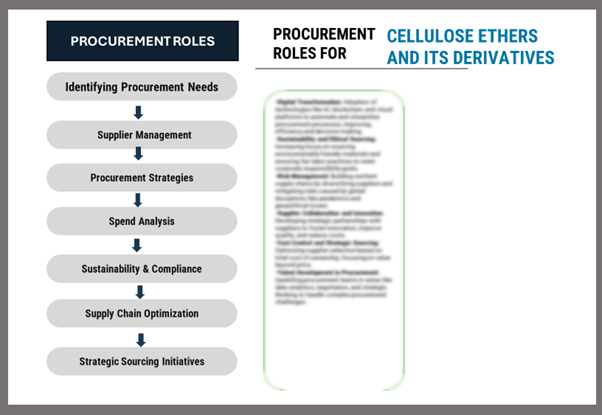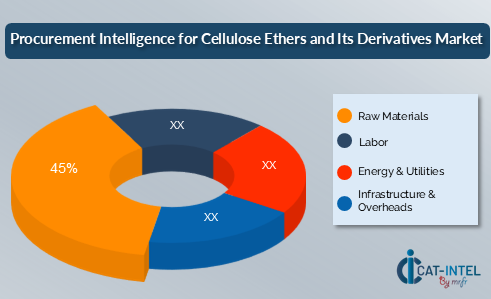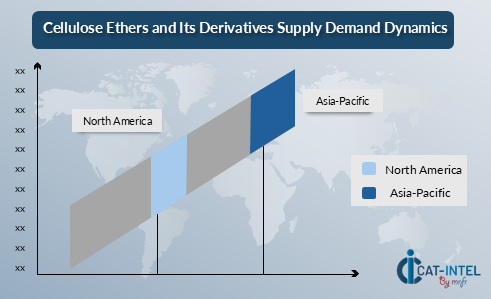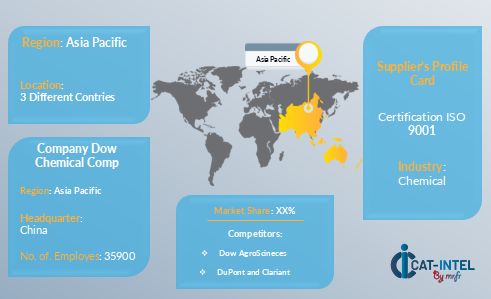Cellulose Ethers Market Overview:
The global market for cellulose ethers and their derivatives is witnessing steady growth, fuelled by demand across industries such as pharmaceuticals, construction, personal care, and food processing. This market includes a variety of products like methylcellulose, hydroxypropyl methylcellulose (HPMC), and carboxymethylcellulose (CMC). The report provides an in-depth analysis of procurement trends, with a focus on cost optimization and the adoption of advanced tools to streamline procurement and production processes.
Key challenges in procurement include managing the volatility of raw material prices, ensuring a stable supply chain, and addressing rising regulatory compliance demands. Digital procurement solutions and strategic sourcing practices are essential to improve supply chain resilience and maintain long-term competitiveness. As global demand grows, businesses are leveraging market intelligence to enhance efficiency and reduce procurement-related risks.
The cellulose ethers market is expected to maintain a robust growth trajectory through 2032, with key highlights including:
- Market Size: The global cellulose ethers market is projected to reach USD 4.2 billion by 2032, growing at a CAGR of approximately 4.4% from 2024 to 2032.
Growth Rate: 4.4%
- Sector Contributions: Growth is driven by:
- Pharmaceutical Demand: Increased use in drug formulations as binders, thickeners, and stabilizers.
- Construction Sector Needs: High demand for cellulose ethers in construction materials such as cement, adhesives, and paints.
- Personal Care and Food: Expanding applications in food stabilizers and personal care products like shampoos and lotions.
- Technological Innovations: Advancements in production processes, including environmentally friendly and cost-efficient methods, are enhancing product quality and reducing waste.
- Regional Insights: Asia-Pacific is a dominant market contributor due to the rapid growth of construction, food processing, and pharmaceutical industries in the region.
Key Trends and Sustainability Outlook:
- Enhanced Digital Integration: Automation in production and procurement processes is improving operational efficiency and reducing costs.
- Eco-Friendly Innovations: The development of biodegradable cellulose ethers aligns with growing sustainability goals.
- Regulatory Compliance: Companies are focusing on adhering to stringent environmental and safety regulations, especially in pharmaceuticals and food industries.
- Customization Demand: Rising need for tailored formulations to meet specific industrial and consumer needs.
- Data-Driven Optimization: Adoption of big data and analytics for better production planning and quality assurance.
Growth Drivers:
- Pharmaceutical Expansion: Growing demand for excipients and controlled-release formulations in the pharmaceutical sector.
- Construction Boom: Increased urbanization and infrastructure projects driving demand for high-performance construction materials.
- Food Industry Growth: Rising use as stabilizers and thickeners in processed and packaged foods.
- Sustainability Trends: Investments in green manufacturing processes and bio-based derivatives.
- Product Customization: Tailored solutions for unique applications in various sectors, including cosmetics and industrial applications.
Overview of Market Intelligence Services for Cellulose Ethers and Derivatives:
Market analyses identify major procurement challenges, such as price volatility of raw materials like cellulose pulp and increasing customization complexities. Market intelligence provides actionable insights to uncover cost-saving opportunities, optimize vendor management, and improve supply chain stability. These insights enable companies to ensure compliance, maintain high product quality, and effectively manage procurement costs.
Procurement Intelligence for Cellulose Ethers and Derivatives: Category Management and Strategic Sourcing:
To stay competitive, businesses are refining their procurement processes by using spend analysis to track vendors and employing strategic sourcing for cost-effective procurement. Effective category management ensures consistent quality and minimizes procurement risks. Leveraging market intelligence enables businesses to develop robust procurement strategies, streamline supplier relationships, and secure favourable terms for their cellulose ether requirements.

Pricing Outlook for Cellulose Ethers and Its Derivatives: Spend Analysis
The pricing outlook for cellulose ethers and their derivatives is expected to remain moderately stable, with potential increases influenced by several critical factors. Fluctuating raw material costs, particularly cellulose pulp prices, driven by climatic conditions and supply-demand dynamics, significantly impact overall pricing trends. Furthermore, rising demand for high-performance and sustainable cellulose ether products across industries such as construction, pharmaceuticals, and food is creating upward price pressure.
Graph shows general upward trend pricing for cellulose ethers and its derivatives and growing demand. However, there may be fluctuations influenced by economic conditions, technological advancements, and competitive dynamic. 
Efforts to enhance production efficiency, reduce waste, and adopt advanced manufacturing technologies, including automated processes, are essential for cost management. The incorporation of eco-friendly raw materials and innovative production techniques further contributes to mitigating price increases. Collaborating with reliable suppliers, focusing on sustainable sourcing practices, and optimizing supply chain logistics are crucial strategies to control costs.
Despite these challenges, maintaining a strong emphasis on quality assurance, regulatory compliance, and continuous investment in research and development will play a key role in effectively managing pricing dynamics.
Cost Breakdown for Cellulose Ethers and Its Derivatives: Total Cost of Ownership (TCO) and Cost-Saving Opportunities

- Raw Materials (45%)
- Description: Raw materials include cellulose pulp, chemical reagents, and additives used in the production of cellulose ethers. These inputs must meet stringent quality standards to ensure product performance and compliance with industry regulations.
- Trends: Increasing demand for bio-based and sustainable cellulose sources is driving changes in procurement practices. Suppliers are adopting advanced cultivation and processing methods to enhance raw material quality and align with eco-friendly initiatives.
- Labor (XX%)
- Energy & Utilities (XX%)
- Infrastructure & Overheads (XX%)
Cost-Saving Opportunities: Negotiation Lever and Purchasing Negotiation Strategies
In the cellulose ethers industry, improving procurement strategies and optimizing production techniques can lead to significant cost savings and operational efficiencies. Establishing long-term relationships with cellulose pulp suppliers, particularly in key production regions, allows for bulk purchasing discounts, which can reduce overall material costs. Strategic collaborations with manufacturing facilities can yield cost benefits through better payment terms and increased production efficiencies.
Investing in advanced technologies, such as automated production lines and quality control systems, can help lower labor costs, enhance precision in manufacturing, and minimize waste. Adopting energy-efficient manufacturing processes and sourcing sustainable raw materials can further reduce operating costs while appealing to environmentally conscious customers. Moreover, implementing multi-sourcing strategies can mitigate risks related to supply chain disruptions and enhance bargaining power with suppliers.
Supply and Demand Overview for Cellulose Ethers and Its Derivatives: Demand-Supply Dynamics and Buyer Intelligence for Effective Supplier Relationship Management (SRM)
The cellulose ethers market is experiencing steady growth, driven by increasing demand across industries such as construction, pharmaceuticals, and food. Supply-demand dynamics are shaped by factors like evolving customer requirements, production innovations, and global market conditions.
Demand Factors
- Rising Use in Construction Applications: Growing demand for cellulose ethers in construction, particularly for applications like cement additives and tile adhesives, is driving market expansion.
- Pharmaceutical Industry Growth: Increasing use of cellulose ethers in drug formulations, especially for controlled release and coating applications, boosts demand.
- Food Industry Applications: The rising need for cellulose ethers as stabilizers, thickeners, and emulsifiers in processed food drives market growth.
- Sustainable and High-Performance Products: Growing consumer preference for eco-friendly and high-performance cellulose derivatives is shaping procurement trends.
Supply Factors
- Raw Material Availability: The supply of cellulose pulp, a primary raw material, is influenced by forestry practices and climatic conditions, impacting supply consistency.
- Technological Innovations: Advances in production technologies, such as automated mixing and coating processes, enhance efficiency and product quality.
- Skilled Workforce: Availability of trained personnel for production and quality assurance is critical to maintaining consistent supply standards.
- Supplier Competition: Strong competition among cellulose ether manufacturers ensures high-quality products and competitive pricing for buyers.
Regional Demand-Supply Outlook: Cellulose Ethers and Its Derivatives
The Image shows growing demand for cellulose ethers and its derivatives in both Asia Pacific and North America, with potential price increases and increased Competition. 
Asia-Pacific: Dominance in Cellulose Ethers and Its Derivatives
The Asia-Pacific region, particularly countries like China, India, and Japan, plays a leading role in the global cellulose ethers market, supported by several key factors:
- Major Production Hubs: Asia-Pacific is home to some of the world’s largest cellulose ether manufacturing facilities, backed by abundant raw material availability, including cellulose pulp sourced from extensive forestry resources.
- Advanced Manufacturing Capabilities: The region boasts state-of-the-art production facilities equipped with innovative technologies for efficient processing, ensuring high-quality cellulose ether products tailored to meet diverse industrial requirements.
- Cost-Effective Production: The availability of skilled yet cost-effective labor and lower operational expenses in major producing countries provide Asia-Pacific with a competitive advantage in delivering economically priced cellulose ethers globally.
- Export Leadership and International Presence: Asia-Pacific nations, particularly China and India, are leading exporters of cellulose ethers, supplying superior-grade products to markets in North America, Europe, and the Middle East, thereby driving global market expansion.
- Emphasis on Quality and Sustainability: Manufacturers in the region are increasingly adopting eco-friendly production methods and rigorous quality control measures to align with international standards and cater to the growing demand for sustainable and high-performance cellulose ether derivatives.
Asia Pacific Remains a key hub cellulose ether and its derivatives price drivers Innovation and Growth.
Supplier Landscape: Supplier Negotiations and Strategies
The supplier landscape in the cellulose ethers and derivatives market is evolving, with a combination of global and regional suppliers driving industry growth. These suppliers play a pivotal role in shaping various market factors, including pricing, product quality, and supply chain efficiency. The market is highly competitive, with large multinational suppliers leading global trade, while smaller, specialized firms focus on niche markets, such as bio-based and high-performance cellulose ether products.
The supplier landscape in major cellulose ether-producing countries remains active, with both established players and emerging suppliers meeting the global and regional demand. As key producers, suppliers in these regions are increasingly focusing on innovation, sustainability, and forming strategic partnerships to strengthen their market position and meet the growing demand for high-quality, eco-friendly cellulose ether solutions.
Key Suppliers in the Cellulose Ethers and Derivatives Market:
- Dow Chemical Company
- Shin-Etsu Chemical Co., Ltd.
- AkzoNobel
- Sanjay Chem Industries
- Cellulose Solutions
- Hawkins, Inc.
- BASF SE
- The Dow Chemical Company
- National Petroleum Corporation
- Nouryon (formerly AkzoNobel Industrial Chemicals)

Key Developments Procurement Category Significant Development:
|
Significant Development |
Description |
|
Market Growth |
The global cellulose ethers market is expanding, driven by increasing demand across industries such as construction, pharmaceuticals, food, and personal care. |
|
Sustainable Practices |
Emphasis on eco-friendly production methods and sustainable sourcing of cellulose to meet regulatory standards and consumer demand for environmentally responsible products. |
|
Product Diversification |
Growth in the variety of cellulose ether products, including bio-based, high-performance, and customized solutions, to cater to diverse industry needs and applications. |
|
Technological Innovations |
Adoption of advanced processing technologies, such as automated manufacturing systems and improved purification methods, to enhance product quality and production efficiency. |
|
E-commerce Expansion |
The rise of online sales platforms enables broader access to cellulose ether products, catering to both industrial and smaller-scale consumers. |
|
Focus on Miniaturization |
Increased demand for specialized, small-scale packaging for certain applications, such as in pharmaceuticals and cosmetics, to meet consumer and market needs for convenience. |
|
Regional Manufacturing Hubs |
Establishment of production facilities in key regions such as China, India, and Europe to optimize supply chain management and reduce production costs. |
|
Cellulose Ethers and Its Derivatives Attribute/Metric |
Details |
|
Cellulose Ethers and Its Derivatives Market Sizing |
The global cellulose ethers market is projected to reach USD 4.2 billion by 2032, growing at a CAGR of approximately 4.4% from 2024 to 2032. |
|
Technology Cellulose Ethers and Its Derivatives Adoption Rate |
Around 40% of cellulose ether manufacturers are adopting cutting-edge technologies, such as advanced mixing and drying systems, and digital monitoring for product consistency and quality control. |
|
Top Cellulose Ethers and Its Derivatives Strategies for 2024 |
Focus on expanding the portfolio of eco-friendly and bio-based cellulose derivatives, improving manufacturing efficiency, and ensuring compliance with environmental regulations. |
|
Cellulose Ethers and Its Derivatives Process Automation |
30% of cellulose ether production companies have automated processes such as mixing, drying, and packaging to enhance production speed, reduce waste, and ensure uniform quality. |
|
Cellulose Ethers and Its Derivatives Process Challenges |
Major challenges include fluctuations in raw material costs, scaling sustainable production practices, and ensuring consistent quality amidst increased demand for high-performance cellulose ethers. |
|
Key Suppliers |
Leading suppliers include Dow Chemical, Ashland Global, and Nouryon, offering a wide range of cellulose ether products for industries such as construction, pharmaceuticals, and food. |
|
Key Regions Covered |
The key manufacturing regions include North America, Europe, and Asia-Pacific, with China, India, and the U.S. being significant producers of cellulose ethers. |
|
Market Drivers and Trends |
Growth driven by increasing demand for cellulose ethers in construction (as thickeners), pharmaceuticals (as excipients), and food (as stabilizers), along with rising demand for bio-based and eco-friendly alternatives. |
Frequently Asked Questions (FAQ):
Our procurement intelligence services provide comprehensive analysis of the cellulose ether supplier landscape, identifying key manufacturers and offering insights into market trends. We offer spend analysis, supplier evaluations, and strategic sourcing advice to ensure cost-effective procurement of high-quality cellulose ethers
We assist in evaluating the TCO for cellulose ethers by considering costs such as raw material prices, production expenses, packaging, transportation, and storage. Our detailed cost analysis helps you understand the overall financial impact and make informed procurement decisions.
Our risk management solutions address challenges such as supply chain disruptions, price fluctuations of raw materials, and supplier reliability. We provide strategies to ensure a steady supply while maintaining product quality and minimizing financial risks.
Our Supplier Relationship Management (SRM) services help build strong, long-term relationships with cellulose ether suppliers. We assist with contract negotiations, performance evaluations, and quality control to ensure a reliable supply at competitive terms.
We recommend procurement best practices such as supplier segmentation, cost-benefit analysis, inventory optimization, and ongoing performance monitoring. These practices help you source cellulose ethers efficiently while controlling costs.
Digital tools enhance cellulose ether procurement by automating processes and offering real-time data insights. Utilizing data-driven platforms helps track supplier performance, optimize stock levels, and streamline procurement operations for greater efficiency
Our supplier performance management services track key performance indicators (KPIs) such as quality, delivery timelines, and compliance. This ensures suppliers meet expectations, facilitating better decision-making for future procurement.
We assist with negotiation strategies by providing market intelligence, benchmarking supplier pricing, and leveraging volume discounts or long-term agreements. These tactics help secure favourable terms and additional value in your contracts.
We offer market analysis tools that deliver insights into global trends, pricing variations, supplier performance, and demand forecasts. These resources empower you to make informed, data-driven procurement decisions.
We guide you in ensuring compliance with regulatory and ethical standards, ensuring your suppliers meet quality, safety, and sustainability requirements. This includes verifying certifications and ensuring adherence to industry guidelines.
Our solutions for managing supply chain disruptions involve identifying alternative suppliers, diversifying procurement sources, and establishing contingency plans. These strategies ensure continuity of supply during unforeseen disruptions.
Our performance tracking tools allow you to assess suppliers by monitoring key metrics such as delivery accuracy, product quality, and compliance. This helps improve supplier selection and informs future procurement decisions.
We assist in identifying suppliers who follow sustainable practices, including eco-friendly sourcing, reducing waste, and ethical labor practices. This ensures that your cellulose ether sourcing meets environmental and social responsibility standards.
Our pricing analysis services compare supplier costs, track pricing trends, and employ negotiation strategies to help you secure competitive pricing without sacrificing quality or performance.








